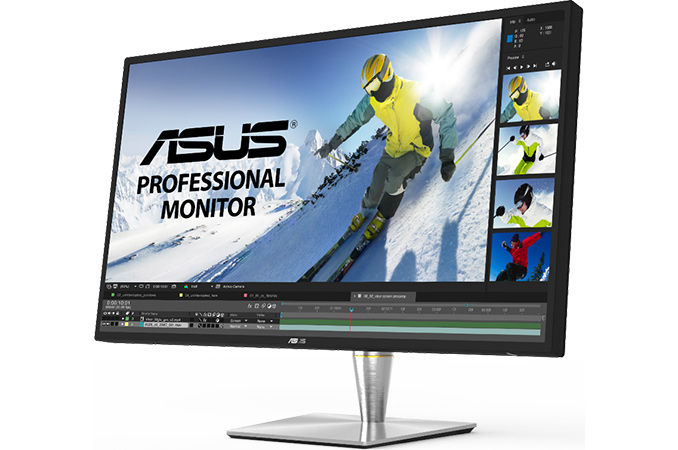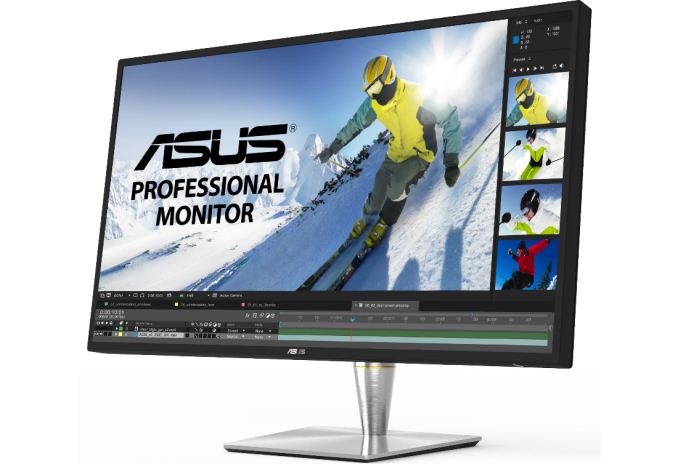ASUS ProArt PA32U Display: 4K, 1000 Nits Brightness, 95% DCI-P3, 85% Rec. 2020
by Anton Shilov on January 6, 2017 11:15 AM EST
ASUS introduced a new professional-grade monitor at CES this week. The unit supports a 4K (UHD) resolution, HDR10, a very high brightness and an astonishing range of color gamuts required by artists, designers, photographers and video professionals today, including the Rec. 2020 (BT.2020) standard. The ProArt PA32U will be available in the second half of this year at a rather hefty price tag, as you can imagine. In addition, ASUS announced its ProArt PA27AQ monitor aimed at the entry level segment of the professional market.
The ASUS ProArt PA32U uses a 4K UHD panel with HDR capabilities, a quantum dot film and a special backlight featuring 384 LED zones that enable 1000-nit brightness and support for local dimming. The manufacturer notes that its new panel with quantum dots, backlighting and calibration enable the monitor to cover 99.5% of the Adobe RGB, 85% of the Rec. 2020, 100% of the sRGB and 95% of the DCI-P3 color spaces, which makes the display particularly appealing to artists and photographers (Adobe RGB) as well as to video editors and animation designers who do post-production work for digital cinema or TV (DCI-P3 and BT.2020). The number of features, as well as the use of quantum dot technology, represents an interesting combination for a professional display. Moreover, it looks like the ASUS ProArt PA32U will be one of the first mass-market monitors supporting the Rec. 2020 color gamut at all and covering 85% of it.
| The ASUS ProArt Displays Specifications | ||
| ProArt PA32U | ProArt PA27AQ | |
| Panel | 32" with quantum dots | 27" IPS |
| Native Resolution | 4K | 2560 × 1440 |
| Maximum Refresh Rate | 60 Hz (?) | |
| Brightness | 1000 cd/m² | unknown |
| Contrast | high | unknown |
| Viewing Angles | 178°/178° horizontal/vertical (?) | |
| Pixel Pitch | 0.185 mm | 0.233 mm |
| Pixel Density | 138 ppi | 109 ppi |
| Anti-Glare Coating | Yes (?) | |
| Color Gamut | Adobe RGB: 99.5% DCI-P3: 95% sRGB: 100% Rec. 2020: 85% |
sRGB: 100% |
| Inputs | 1 × Thunderbolt 3 1 × DP 1.2 (?) |
1 × Thunderbolt 3 1 × DP 1.2 (?) |
| Extras | ASUS ProArt Calibration with color parameters saved locally | |
The ProArt PA32U monitor will be calibrated at the factory, but people with appropriate equipment will be able to further tune them their particular needs. The ProArt PA32U stores all the color parameters locally (and not on the PC), so users will be able to use it with different devices without the necessity to recalibrate it. This will be particularly valuable for those who works on Apple macOS and Microsoft Windows platforms. To hook up the monitor to either PC, the PA32U is equipped with a Thunderbolt 3 input (which means DP 1.2 over a USB-C cable), but we do not know whether other ports are supported.
Since this is a preliminary announcement, ASUS does not disclose whether it uses an IPS or VA panel, or if the TFT is ASi or IGZO (like it used for its previous-generation flagship professional display) for its PA32U as well as details about the LUTs (look-up-tables), refresh rate and so on. We do understand that the panel is an LCD based on usage of quantum dots and high, but not prohibitively high, price.
For people who do not need 4K UHD resolution, Rec. 2020 or DCI-P3 color spaces and HDR, ASUS plans to offer its 27” ProArt PA27 AQ monitor with 2560 × 1440 resolution, sRGB color gamut and Thunderbolt 3 input. The monitor will also come pre-calibrated and will support the same ProArt Calibration features as its bigger brother (color-accuracy tuning, uniformity compensation local store of parameters, etc.).
The ASUS ProArt PA32U will be available in Q3 2017 for $1799 – $1999.
Pricing of the ProArt PA27AQ (as well as its availability timeframe) are unknown.
Related Reading:
- LG Announces 32UD99: 4K IPS Display with 95% DCI-P3, HDR and USB-C
- BenQ Launches the SW320: a 4K Display with HDR for Professionals
- Panasonic Develops IPS Panel with 1,000,000:1 Contrast Ratio, 1000 Nits Brightness
- EIZO Launches ColorEdge CG2730 and CS2730 2560×1440 Displays for Professionals and Prosumers
- Dell Introduces UltraSharp UP3017 30-Inch Professional Display with 16:10 Aspect Ratio and DCI-P3 Color Space
Source: ASUS











30 Comments
View All Comments
boozed - Saturday, January 7, 2017 - link
I can't tell whether you're joking.Anyway that would require three times the density of FHD rather than "merely" twice FHD.
javishd - Sunday, January 8, 2017 - link
138 is a bit awkward, but it's definitely not a joke... In Windows you need to hit 150% display scaling to get into high-DPI mode.Most 4k displays fall into 2 categories in terms of size.
A - Large enough that they are for desktops and target 150% display scaling
B - Small enough that they are for laptops and target 200%+ display scaling.
4K scaled 150% gets you the real-estate of a 1440p display
4K scaled 200% gets you 1080p real-estate
If the display was super small like 10-12" you could target 300% scaling and get a 720p amount of real-estate
Back to the 138 joke. 32" monitors at 1440p look perfectly fine, everything is a little bigger since this amount of space is more typical for 27-30" screens. In high-DPI mode it's still going to look sharp, just a little blown up. Either you would welcome the bigger sharp fonts or you would skooch this back a litter further on your desk! :D
zepi - Sunday, January 8, 2017 - link
32" 4K display is just as fine as 960x540 at somewhere around 4.5-5" display or thereabouts.Ie. Not fine at all once you've gotten used to 300+dpi in smart phones and 200+dpi in tablets and around 200dpi in desktop monitors.
Lower than this just looks pixellated and not sharp.
zepi - Sunday, January 8, 2017 - link
Dell seems to be bringing out 32" 8K monitor this spring:http://www.dell.com/learn/us/en/uscorp1/secure/201...
Lolimaster - Sunday, January 8, 2017 - link
You're not looking a PC monitor below 40-50cm.javishd - Monday, January 9, 2017 - link
"32" 4K display is just as fine as 960x540 at somewhere around 4.5-5" display or thereabouts."-This is nonsense.
Do you talk crap about all the 4k screens that are bigger than 20"?
zepi - Monday, January 9, 2017 - link
Yes. 4K (3840x2160) is inadequate to be considered "perfect" for anything bigger than about 20" for desktop monitors. Remember what perfect stands for. Really flawless. Good or even great is not perfect.I personally have a 24" 4K screen on my desk at around 70cm viewing distance and I don't consider it being perfect in terms of visual resolution. It is good and easily above "adequate", but it is not perfect and anyone claiming must have overlooked some the slight inadequacy of the finest details. I can still see some "fuzzyness" in font rendering, depending on the algorithm used and a bit higher DPI would make everything a little bit more sharp still. And no, I'm not saying it is "horrible" or "bad". Just that 240dpi would be better than 185dpi that I have now and it would be visible with naked eye (and I don't have perfect or even exceptional eye-sight, just decent perception when I try).
Just the same way as ipads 9.7" 264dpi 2048x1536 screen is not perfect either, since individual pixels are still visible and higher dpi would make rendering of small fonts better / less fuzzy.
Even iPhones "retina" could benefit from somewhat higher dpi as Apples smooth font rendering would require higher dpi to look really sharp with very small text sizes.
javishd - Monday, January 9, 2017 - link
By all means, be the authority on perfection.It's just funny that even though 4K is basically the highest res you can obtain now (and will cost you $5000 to exceed later this year) you are basically telling the display manufacturers, "Yeah this is ok, but can you make the display smaller please?"
Do you not multi-task? When your total number of pixels is constrained, why would you want them to be small enough that you can no longer see them?
zepi - Monday, January 9, 2017 - link
5K 27" monitors have been available "cheaply" for a while already.tuxRoller - Wednesday, January 10, 2018 - link
This shouldn't really be an issue with this dpi if your desktop supports high quality system-level (implemented by the compositor) fractional scaling.